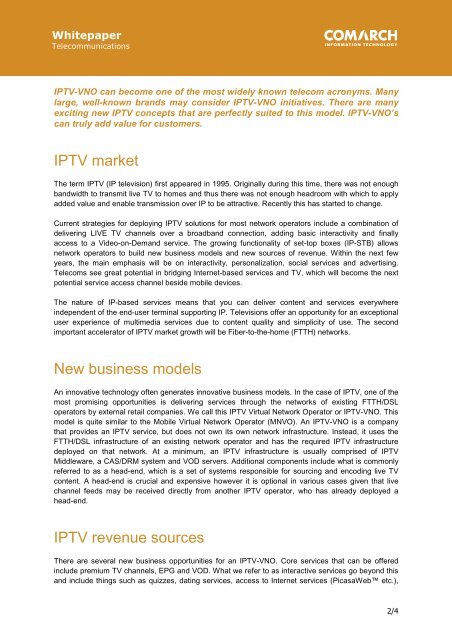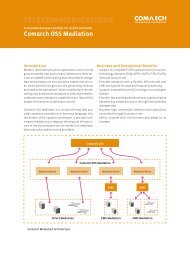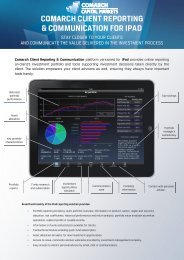IPTV-VNO - Comarch
IPTV-VNO - Comarch
IPTV-VNO - Comarch
- TAGS
- comarch
- www.comarch.com
You also want an ePaper? Increase the reach of your titles
YUMPU automatically turns print PDFs into web optimized ePapers that Google loves.
Whitepaper<br />
Telecommunications<br />
<strong>IPTV</strong>-<strong>VNO</strong> can become one of the most widely known telecom acronyms. Many<br />
large, well-known brands may consider <strong>IPTV</strong>-<strong>VNO</strong> initiatives. There are many<br />
exciting new <strong>IPTV</strong> concepts that are perfectly suited to this model. <strong>IPTV</strong>-<strong>VNO</strong>’s<br />
can truly add value for customers.<br />
<strong>IPTV</strong> market<br />
The term <strong>IPTV</strong> (IP television) first appeared in 1995. Originally during this time, there was not enough<br />
bandwidth to transmit live TV to homes and thus there was not enough headroom with which to apply<br />
added value and enable transmission over IP to be attractive. Recently this has started to change.<br />
Current strategies for deploying <strong>IPTV</strong> solutions for most network operators include a combination of<br />
delivering LIVE TV channels over a broadband connection, adding basic interactivity and finally<br />
access to a Video-on-Demand service. The growing functionality of set-top boxes (IP-STB) allows<br />
network operators to build new business models and new sources of revenue. Within the next few<br />
years, the main emphasis will be on interactivity, personalization, social services and advertising.<br />
Telecoms see great potential in bridging Internet-based services and TV, which will become the next<br />
potential service access channel beside mobile devices.<br />
The nature of IP-based services means that you can deliver content and services everywhere<br />
independent of the end-user terminal supporting IP. Televisions offer an opportunity for an exceptional<br />
user experience of multimedia services due to content quality and simplicity of use. The second<br />
important accelerator of <strong>IPTV</strong> market growth will be Fiber-to-the-home (FTTH) networks.<br />
New business models<br />
An innovative technology often generates innovative business models. In the case of <strong>IPTV</strong>, one of the<br />
most promising opportunities is delivering services through the networks of existing FTTH/DSL<br />
operators by external retail companies. We call this <strong>IPTV</strong> Virtual Network Operator or <strong>IPTV</strong>-<strong>VNO</strong>. This<br />
model is quite similar to the Mobile Virtual Network Operator (MNVO). An <strong>IPTV</strong>-<strong>VNO</strong> is a company<br />
that provides an <strong>IPTV</strong> service, but does not own its own network infrastructure. Instead, it uses the<br />
FTTH/DSL infrastructure of an existing network operator and has the required <strong>IPTV</strong> infrastructure<br />
deployed on that network. At a minimum, an <strong>IPTV</strong> infrastructure is usually comprised of <strong>IPTV</strong><br />
Middleware, a CAS/DRM system and VOD servers. Additional components include what is commonly<br />
referred to as a head-end, which is a set of systems responsible for sourcing and encoding live TV<br />
content. A head-end is crucial and expensive however it is optional in various cases given that live<br />
channel feeds may be received directly from another <strong>IPTV</strong> operator, who has already deployed a<br />
head-end.<br />
<strong>IPTV</strong> revenue sources<br />
There are several new business opportunities for an <strong>IPTV</strong>-<strong>VNO</strong>. Core services that can be offered<br />
include premium TV channels, EPG and VOD. What we refer to as interactive services go beyond this<br />
and include things such as quizzes, dating services, access to Internet services (PicasaWeb etc.),<br />
2/4

















